Well, I’ve been itching to properly use the D4 since it arrived last week, and it certainly got put it to the test on it’s first outing. Not only did I get some great pheasant activity but also an unexpected badger encounter as the light faded in the late evening. So it was great to see how the D4 would handle real world use, in low light and with some high speed action, and needless to say it handled it all in it’s stride.
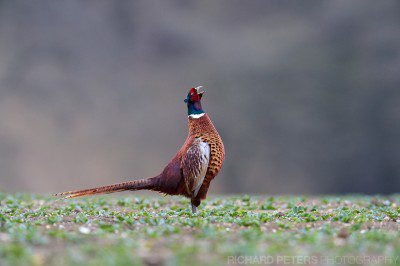
Nikon D4, 600 VR + 1.4x TC, 1/320, f8, ISO 1800
The day started a little later than normal, as I’d usually be out the house before sunrise. But on this occasion, the forecast wasn’t great with lots of cloud predicted, so a leisurely morning was had before setting off to meet fellow photographer Luke Massey for the afternoon.
Our actual main aim of the day was to check out a potential fox den, but the area we need to visit for that is abundant with pheasants, a bird that I feel is often overlooked. However at this time of year, the males especially are very active with lots of displaying and calling out, not to mention fighting over the female of the species. Given our destination was on some private land, which we have been granted access to, getting there required walking up a small hill and around the outside of a large field to some woods at the far end. The field was full of distant pheasants and as we reached elevated ground a single male was coming up over the brow of the hill. Getting down low to the ground we trained our cameras on the bird as he wondered around, digging up food from the soil. Of course, at this point, with all the distant males calling out, we figured ours would do so quite quickly. However, a good 20 minutes passed with no sign of display, and, as he was now walking further away again I decided it would be a good time to grab my bag and add my teleconverter. Of course, during the 15 seconds in which it took to do this, our friend decided it would be the perfect time to display! Damn. Sods law, school boy error, call it what you will. Me personally, I go with typical!
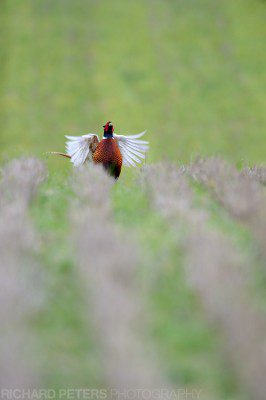
Nikon D4, 600 VR, 1/640,f5.6, ISO 500
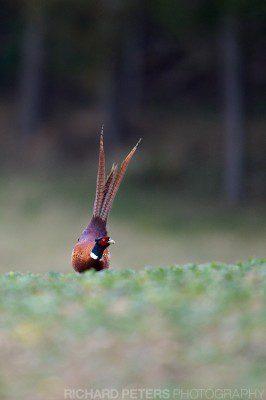
D4, 600 VR, 1/1600, f4, ISO 1100
As with most wildlife, the waiting game always pays off and we stuck with this one particular bird for over an hour, watching as it wondered around the field at close quarters and occasionally made itself known vocally. With our elevated position and the field dropping off in to a slope in the distance, which allowed for some really nice backgrounds. Of course after the bad timing of reaching for my 1.4x teleconverter, it was pretty much not coming off again now and so I opted to mainly shoot at 1/1600 second and at f8, because when these birds display, the action is fast and I wanted to maximise the sharpness of the lens/tc combo and the depth of field as they move about quite a bit when displaying.
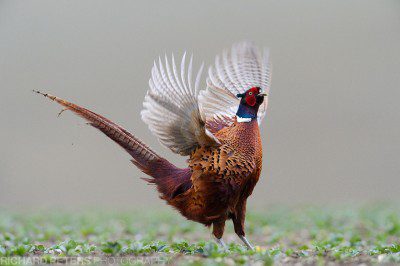
Nikon D4, 600 VR + 1.4x, 1/1600, f8, ISO 9000
This resulted in quite high ISOs at times depending on how thick the rolling cloud cover was. But, given the D4 and the D3s are all but identical with the high ISO image quality, I had every confidence that this wouldn’t be a problem. Photographing the quick display behaviour did also draw my attention to one thing, just how responsive and fast the D4 shutter feels. Firing off a burst of shots feels so much snappier, and the speed in which the XQD card writes to clear the buffer is crazy!
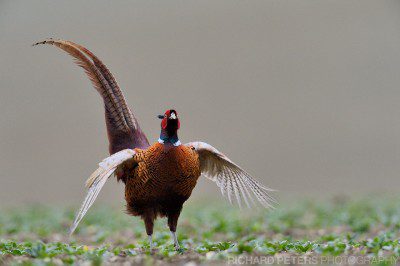
Nikon D4, 600 VR + 1.4x TC, 1/1600, f8, ISO 3600
What also stood out for me on this shoot, was the auto focus speed with the 1.4x TC attached. It was always good on the D3s but now, on the D4 it feels even faster and less prone to hunting in the outer focus points in less than bright light. A definite improvement.
More than an hour in to watching our very obliging subject, Luke spotted another male heading across the field and up the hill fast. That could only mean one thing, a fight was on the cards and we had front row seats! The challenger chased our bird in to the grass at the side of the field and then, what can only be described as the longest stand off in history took place. Both birds squared up to each other, walking around in circles and bobbing their heads up and down. Given I had by this point removed my camera from the low level set tripod, in order to quickly move to a better position, you only imagine how this drawn out standoff was not amusing me as the 600 VR began tiring my arms as I was now hand holding. It was like an endurance test to see what would happen first, my arms giving out or the pheasants breaking the stand off and fighting. I knew I could potentially be in trouble, as I still had my 1.4x TC on, and now had two (large) birds to fit in the frame> Equally though, I couldn’t risk taking my eye away from them to remove the converter, not after what had happened earlier!
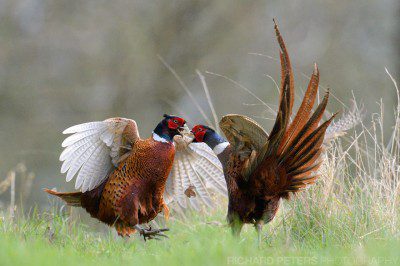
Nikon D4, 600 VR + 1.4x, 1/1600, f8, ISO 9000
The stand off lasted several minutes and after two bursts of energetic fighting I had to rest the camera down to go and get my tripod. Unfortunately once I was setup and stable on the tripod, the fight moved in to the thick trees of the woods. Looking back through the images, only two were relatively sharp as most of the time the pheasants were jumping in and out of my depth of field, and waving 850mm of focal length about with over 6kg of camera, I counted myself lucky to get anything at all!
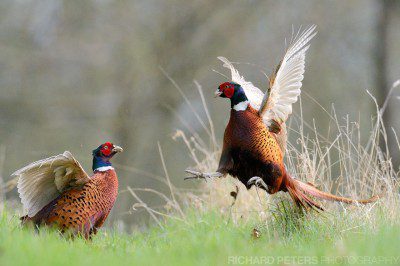
Nikon D4, 600 VR + 1.4x, 1/1600, f8, ISO 9000
After the pheasants moved in to the cover of the woods, we headed on to our original tip off of the fox. As luck would have it, that was no more than 30 yards from where we had previously spent two hours laying at the fields edge, and so we promptly set up and waited, but what we got we saw was so much better than a fox. We sat quietly for an hour, and watched as the light faded, thinking we wouldn’t see anything. In fact, we were on the verge of packing up for the day when Luke spotted something emerging from the ground straight head of us, but it wasn’t a fox. It was a badger. But not just a badger, a badger carrying a cub! She carried it out the Sett, about 30 yards up the hill side before putting it down, where it ran around for a few seconds whilst she wondered off. Then upon her return she prompt picked it back up and took it back to the Sett.
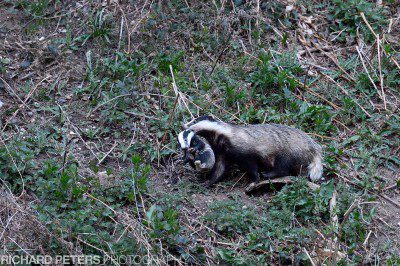
Nikon D4, 600 VR, 1/250, f5, ISO 12800
A minute or so later, another adult emerged and after having a look around for a few seconds casually wondered off in the forest. At this point the light was truly gone, so we waited another ten minutes, then very slowly and quietly backed ourselves up and out of the woods. For those wondering, the D4 had absolutely no trouble focusing in this light, but then I didn’t doubt that for a second. Even after sunset on a cloudy day, under the cover of trees there is more than enough light for it to focus.
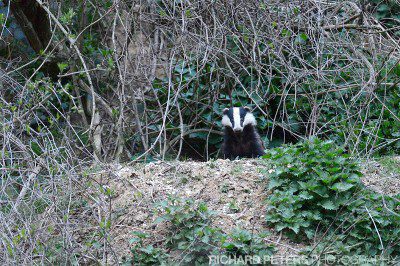
Nikon D4, 600 VR, 1/125, f4, ISO 12800
Given this was just a scouting mission (for a fox) we weren’t really in the right position to get anything special on the photo front, and the light was all but gone. But it didn’t matter. Wow, what an experience, and what a way to see my first ever badger! Incredible stuff and it’s encounters like this that remind me why I love wildlife photography, because even if I don’t get the shot, I get to see these things for real, ad that beats sitting in front of a tv any day!
So all in all, not a bad first days shooting with the D4. It’s certainly proved itself already, and I’ll be writing a more in depth ‘first impressions’ mini review talking about some of the features that stand out to me and comparing it to the D3s a little. But for now, the new camera is off to a flying start and I look forward to seeing what else I can capture on it’s 16mp sensor over the coming year…








